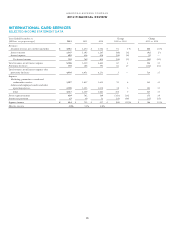American Express 2012 Annual Report Download - page 43
Download and view the complete annual report
Please find page 43 of the 2012 American Express annual report below. You can navigate through the pages in the report by either clicking on the pages listed below, or by using the keyword search tool below to find specific information within the annual report.AMERICAN EXPRESS COMPANY
2012 FINANCIAL REVIEW
BUSINESS SEGMENT RESULTS
The Company is a global service company principally engaged in
businesses comprising four reportable operating segments:
USCS, ICS, GCS and GNMS.
The Company considers a combination of factors when
evaluating the composition of its reportable operating segments,
including the results reviewed by the chief operating decision
maker, economic characteristics, products and services offered,
classes of customers, product distribution channels, geographic
considerations (primarily U.S. versus non-U.S.) and regulatory
environment considerations. Refer to Note 25 to the
Consolidated Financial Statements for additional discussion of
the products and services by segment.
Results of the business segments essentially treat each segment
as a stand-alone business. The management reporting process
that derives these results allocates income and expense using
various methodologies as described below.
Refer to Note 1 to the Consolidated Financial Statements for a
discussion of a change in classification of card fees on lending
products, which impacts the selected income statement and
statistical data presented herein for the USCS and ICS segments.
This change does not impact the net interest yield on
cardmember loans statistic, a non-GAAP measure, for these
segments.
As discussed more fully below, results are presented on a
GAAP basis unless otherwise stated. Refer to the “Glossary of
Selected Terminology” for the definitions of certain key terms
and related information appearing in the tables within this
section.
TOTAL REVENUES NET OF INTEREST EXPENSE
The Company allocates discount revenue and certain other
revenues among segments using a transfer pricing methodology.
Segments earn discount revenue based on the proportion of
merchant business generated by the segment’s cardmembers.
Within the USCS, ICS and GCS segments, discount revenue
reflects the issuer component of the overall discount revenue;
within the GNMS segment, discount revenue reflects the
network and merchant component of the overall discount
revenue. Total interest income and net card fees are directly
attributable to the segment in which they are reported.
PROVISIONS FOR LOSSES
The provisions for losses are directly attributable to the segment
in which they are reported.
EXPENSES
Marketing and promotion expenses are reflected in each segment
based on actual expenses incurred, with the exception of brand
advertising, which is primarily reflected in the GNMS and USCS
segments. Rewards and cardmember services expenses are
reflected in each segment based on actual expenses incurred
within each segment.
Salaries and employee benefits and other operating expenses,
such as professional services, occupancy and equipment and
communications, reflect expenses incurred directly within each
segment. In addition, expenses related to the Company’s support
services, such as technology costs, are allocated to each segment
based on support service activities directly attributable to the
segment. Other overhead expenses, such as staff group support
functions, are allocated to segments based on each segment’s
relative level of pretax income. Financing requirements are
managed on a consolidated basis. Funding costs are allocated
based on segment funding requirements.
CAPITAL
Each business segment is allocated capital based on established
business model operating requirements, risk measures and
regulatory capital requirements. Business model operating
requirements include capital needed to support operations and
specific balance sheet items. The risk measures include
considerations for credit, market and operational risk.
INCOME TAXES
Income tax provision (benefit) is allocated to each business
segment based on the effective tax rates applicable to various
businesses that make up the segment.
41
























